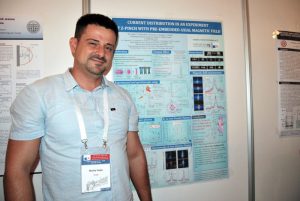Home » Lecture
Category Archives: Lecture
Milica held an invited lecture at 39th Workshop of International School of Atomic and Molecular Spectroscopy
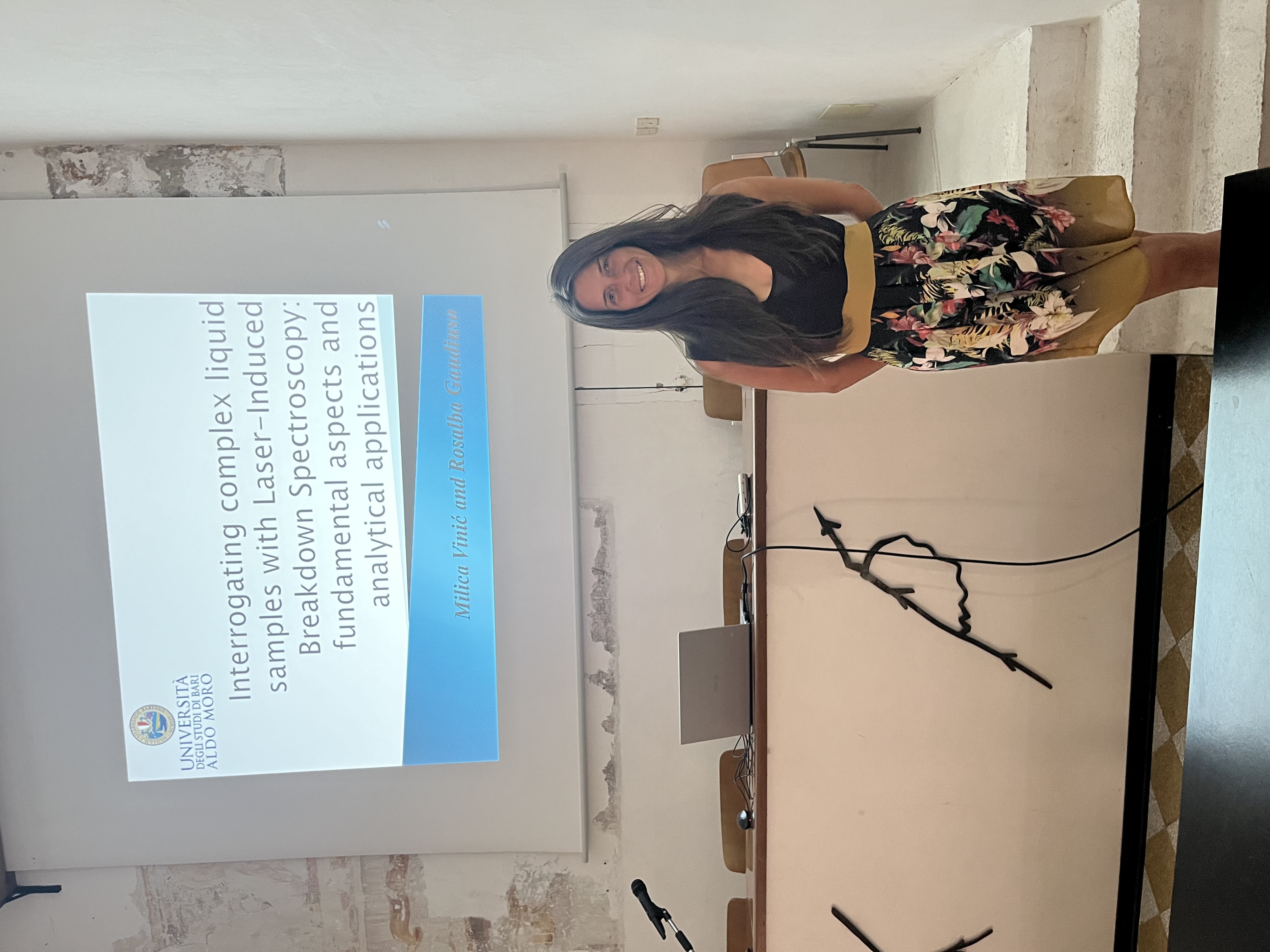 The 39th Workshop of International School of Atomic and Molecular Spectroscopy on “Tracks on Photonics: Advanced materials, devices and methods” was held from 4th – 9th July 2025 in Erice, Italy. Milica was invited to give an invited lecture on her work on diagnostics of Laser Induced Plasma of complex liquid samples. Title of the talk was: Interrogating complex liquid samples with Laser-Induced Breakdown Spectroscopy: fundamental aspects and analytical applications and the abstract of the talk is given below:
The 39th Workshop of International School of Atomic and Molecular Spectroscopy on “Tracks on Photonics: Advanced materials, devices and methods” was held from 4th – 9th July 2025 in Erice, Italy. Milica was invited to give an invited lecture on her work on diagnostics of Laser Induced Plasma of complex liquid samples. Title of the talk was: Interrogating complex liquid samples with Laser-Induced Breakdown Spectroscopy: fundamental aspects and analytical applications and the abstract of the talk is given below:
Laser-Induced Breakdown Spectroscopy (LIBS) has become an increasingly valuable technique for rapid, in-situ elemental analysis, offering minimal sample preparation and real-time analysis capabilities. While LIBS is well-established for solid materials, its application to liquids presents unique challenges that require specialized approaches [1]. This lecture will examine the principles and practical implementation of LIBS for liquid analysis, focusing on the physical and analytical difficulties inherent to the liquid phase. The main experimental approach that we adopted is Surface-Enhanced LIBS (SENLIBS), in which liquid-to-solid conversion is obtained by depositing and drying the liquid sample on solid substrates with carefully chosen physical properties, so to maximize the laser-substrate coupling [2]. We will also present preliminary results obtained with two variants of SENLIBS, i.e., Nanoparticle-Enhanced LIBS (NELIBS) [3] and Laser-Induced Periodic Surface Structures (LIPSS)-enhanced LIBS, in which nanostructures are deposited or generated on the substrates prior to the liquid deposition. Finally, we will present two case studies, i.e., detection of heavy metals in oils and elemental analysis of biomedical fluids, to demonstrate the practical applications and performance of LIBS in complex liquid matrices.
References
[1] K. Keerthi, Sajan D. George, Suresh D. Kulkarni, Santhosh Chidangil, V.K. Unnikrishnan, Elemental analysis of liquid samples by laser induced breakdown spectroscopy (LIBS): Challenges and potential experimental strategies, Optics & Laser Technology, Volume 147, 2022, 107622.
[2] M.A. Aguirre, S. Legnaioli, F. Almodóvar, M. Hidalgo, V. Palleschi, A. Canals, Elemental analysis by surface-enhanced Laser-Induced Breakdown Spectroscopy combined with liquid–liquid microextraction, Spectrochimica Acta Part B: Atomic Spectroscopy, Volumes 79–80, 2013, Pages 88-93.
[3] Z. Salajková, M. Dell’Aglio, V. Gardette, A. De Giacomo, Nanoparticle-Enhanced Laser-Induced Breakdown Spectroscopy, in Laser Induced Breakdown Spectroscopy (LIBS). Concepts, Instrumentation, Data Analysis and Applications, ed. V. K. Singh, D. K. Tripathi, Y. Deguchi and
Z. Wang, John Wiley & Sons, Chichester (UK), 2023.
.
Milica gave an invited lecture at ICSQE2024 conference
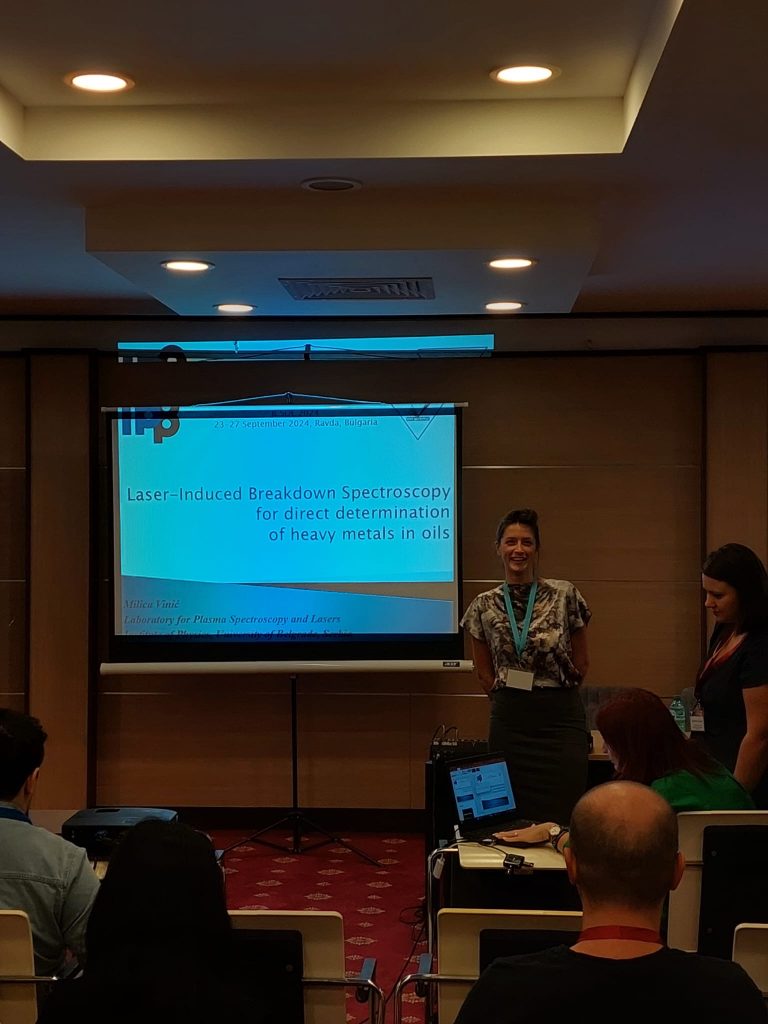 The International Conference and School on Quantum Electronics: “Laser Physics and Applications” (ICSQE 2024) was held from 23rd – 27th March in Ravda, Bulgaria. Milica was invited to give an invited lecture on her work on diagnostics of Laser Induced Plasma from thin oil film. The talk was entitled Laser-induced Breakdown Spectroscopy for direct determination of heavy metals in oils.
The International Conference and School on Quantum Electronics: “Laser Physics and Applications” (ICSQE 2024) was held from 23rd – 27th March in Ravda, Bulgaria. Milica was invited to give an invited lecture on her work on diagnostics of Laser Induced Plasma from thin oil film. The talk was entitled Laser-induced Breakdown Spectroscopy for direct determination of heavy metals in oils.
Ivan presented part of his PhD thesis work on 14th SCSLSA
14th SCSLSA was held in Bajna Bašta from 19th to 23rd June. Ivan was invited to give a progress report on his wok on application of Machine Learning algorithms on the determination of Stark Broadening line widths. The talk was entitled Stark Broadening Modeling with ML and AI Algorithms and abstract is given below. 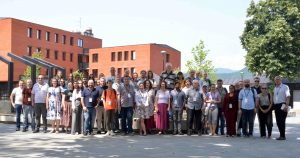
During past 20 years many Stark broadening models were developed that can calculate spectral lineshape and estimate a line width that is extensively used in plasma diagnostics of both astrophysical and laboratory plasmas. Some of these calculations yield results relatively fast, some of them need a lot of computational time. Therefore, idea of creating a machine learning (ML) model emerged as a tool for fast estimation of Stark width without need of huge computational time. In our approach, out of three tested models, random forest (RF) algorithm showed the best predictive power after it has been trained, where the coefficient of determination R2 = 0.94 was obtained. Model was trained on a database created by merging parameters from Stark B and NIST atomic databases, it had 14 input parameters that were used to predict final Stark width. Results were compared with experimental ones as well as with SCP theory. We also checked for regularities in Stark effect, and they were also confirmed and in agreement with previous findings.
Lecture by Biljana at Astronomical Observatory of Belgrade
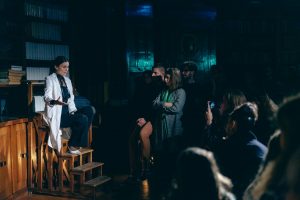 In collaboration with Faculty of Dramatic Arts of University of Belgrade, through project CORIOUS, Biljana held a lecture called
In collaboration with Faculty of Dramatic Arts of University of Belgrade, through project CORIOUS, Biljana held a lecture called 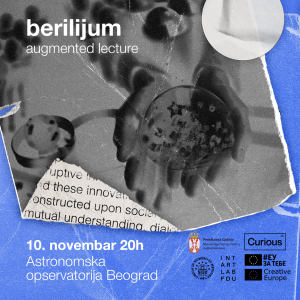 “Beriilium” at Astronomical Observatory of Belgrade. This was a lecture with aim to promote science and to explain at first glance complicated scientific concepts and results to general public with original scenography and special effect, created by her colleagues from FDA. The official abstract of this lecture was:
“Beriilium” at Astronomical Observatory of Belgrade. This was a lecture with aim to promote science and to explain at first glance complicated scientific concepts and results to general public with original scenography and special effect, created by her colleagues from FDA. The official abstract of this lecture was:
Our Augmented Lecture goes high above us into the cosmos, among the stars, using the chemical element called Beryllium. Through it, Dr Biljana Stankov, a research associate at the Institute of Physics in the laboratory for Plasma Spectroscopy and Lasers, and Milica Stojšić, an architect and artist in the field of light design, meet on stage. Inspired by the doctoral research of t he scientist Biljana Stankov, we came to the central question posed by this lecture: is it possible to put the glow of the stars, which we see at night, on our palm and look at it up close? And is it possible to create it? Our lecture will try to “catch” the completely elusive, to clearly “see” what is invisible to the naked eye and to infiltrate into the incredibly complex nature of light, thanks to which we see the whole world around us, and which we cannot perceive and understand independently. In the exceptional ambience of the Observatory on Zvezdara, which is intended for closer acquaintance and observation of the cosmos, we will try to create our own little cosmos on stage, in which the audience will get closer to and shed light on this incredible branch of science, at this exciting, joint site-specific lecture.
he scientist Biljana Stankov, we came to the central question posed by this lecture: is it possible to put the glow of the stars, which we see at night, on our palm and look at it up close? And is it possible to create it? Our lecture will try to “catch” the completely elusive, to clearly “see” what is invisible to the naked eye and to infiltrate into the incredibly complex nature of light, thanks to which we see the whole world around us, and which we cannot perceive and understand independently. In the exceptional ambience of the Observatory on Zvezdara, which is intended for closer acquaintance and observation of the cosmos, we will try to create our own little cosmos on stage, in which the audience will get closer to and shed light on this incredible branch of science, at this exciting, joint site-specific lecture.
Lecture by Dr Blagoje Đorđević (Lawrence Livermore National Laboratory)

It is our great pleasure to inform you, that today our guest Dr Blagoje Đorđević from Lawrence Livermore National Laboratory held a lecture entitled “Transfer learning and multi-fidelity modeling of laser-driven particle acceleration” at library reading room “Dr. Dragan Popović”. The abstract of the talk was:
Computer models of intense, laser-driven ion acceleration require expensive particle-in-cell (PIC) simulations that may struggle to capture all the multi-scale,multi dimensional physics involved at reasonable costs. Explored is an approach to ameliorate this deficiency using a multi-fidelity model that can incorporate physical trends and phenomena at different levels. As the base framework for this study, an ensemble of approximately 10,000 1D PIC simulations was generated to buttress separate ensembles of hundreds of higher fidelity 1D and 2D simulations. Using transfer learning with deep neural networks, one can reproduce the results of more complex physics at a much smaller cost. The networks trained in this fashion can in turn act as surrogate models for the simulations themselves, allowing for quick and efficient exploration of the parameter space of interest. Standard figures-of-merit were used as benchmarks such as the hot electron temperature, peak ion energy, conversion efficiency, etc. These surrogate models are also useful for incorporating more complex schemes, such as pulse shaping. We can rapidly identify and explore under what conditions dimensionality becomes an important effect and search for outliers in feature space.
Ivan participated at SLSP6
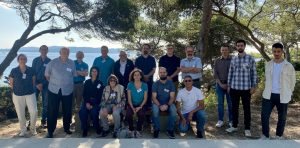 Ivan took participation at 6th Spectral Line Shapes in Plasma Workshop (SLSP6) where he held 15 minute lecture entitled Stark Broadening Modeling with ML Algorithms, in which he presented his recent work on application of machine learning algorithms for modeling of Stark spectral line broadening.
Ivan took participation at 6th Spectral Line Shapes in Plasma Workshop (SLSP6) where he held 15 minute lecture entitled Stark Broadening Modeling with ML Algorithms, in which he presented his recent work on application of machine learning algorithms for modeling of Stark spectral line broadening.
Lecture by Marko
On 23rd October 2019, our Laboratory member Marko Cvejić held an open lecture at the Institute of Physics Belgrade. The lecture was “Challenges in the investigation of compression of magnetized plasma“, where he presented his results obtained at the Weizmann Institute of Science.
Abstract:
The seminar will refer to a compression of magnetic flux that is initially embedded in a plasma that undergoes an implosion. The plasma is produced in a Z-pinch configuration in which a gas puff load is ionized and implodes under the J×B forces resulting from a 1-μs long, 300 kA, current pulse.
The subject of compression of magnetic flux and magnetized plasma is a fundamental problem manifested in a variety of conducting fluid phenomena in laboratory plasmas and astrophysics. Recently, this subject has gained particular interest due to the advances in producing plasmas of high temperature and density for fusion purposes, based on the approach of magnetized plasma compression.
We report the first-time development and employment of spectroscopic methods, based on the Zeeman effect and polarization techniques, to measure both the compressed (axial) and the compressing (azimuthal) magnetic fields throughout the implosion and stagnation processes.
Time and space resolved spectroscopic measurements showed that the application of a relatively weak axial magnetic field (Bz0) has a dramatic effect on the implosion dynamics affecting significantly the current distribution in the plasma [1]. It was found that in the presence of Bz a large part of the current does not flow in the imploding plasma, rather it flows through a slow-imploding low-density plasma (LDP) residing at large radii. Furthermore, it is observed that the fraction of total current that flows in the LDP increases with Bz0.
We suggest an explanation of the phenomena, based on the development of a force-free current configuration. Previously unpredicted observations in high-power magnetized-plasma experiments, including recent unexplained structures observed in the Magnetized Liner Inertial Fusion experiment, may be connected to the present discovery.
References:
[1] Mikitchuk, D., Cvejić, M., Doron, R., Kroupp, E., Stollberg, C.,
Maron, Y., Velikovich, A. L., Ouart, N. D., Giuliani, J. L., Mehlhorn,
T. A., Yu, E. P., and Fruchtman, A. “Effects of a preembedded axial
magnetic field on the current distribution in a Z-pinch implosion”,
Phys. Rev. Lett. 122, 045001 (2019).
Seminar by Ivke and Miloš


On 9th September 2019 Ivke and Miloš held a seminar in the Library “Dr. Dragan Popović” at the Institute of Physics in Belgrade. Ivke had spoken about the topic “Lasers, Laser Produced Plasmas and Optical Emission Spectroscopy”. Shortly after Ivke, Miloš gave the lecture “VUV Spectroscopy of Fusion Plasmas”.
